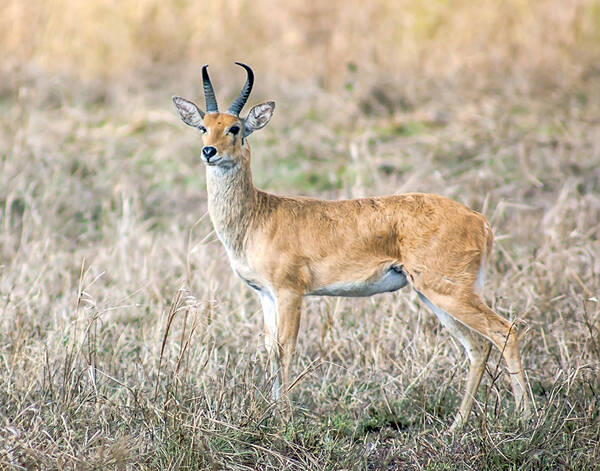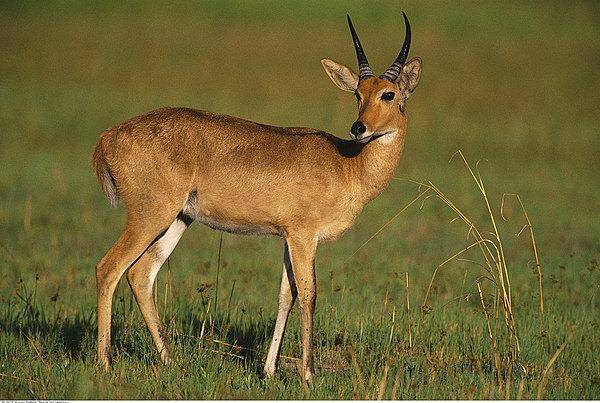Redunca redunca
IUCN
LCBasic Information
Scientific classification
- name:Redunca redunca
- Scientific Name:Common reedbuck, Senegal reedbuck
- Outline:Ungulata
- Family:Artiodactyla Bovidae Koi
Vital signs
- length:Shoulder height 69-89 cm
- Weight:36-55kg
- lifetime:No verification information
Feature
A ring of pale hair around the eyes, lips, jaw, and upper throat
Distribution and Habitat
Origin: Benin, Burkina Faso, Cameroon, Central African Republic, Chad, Democratic Republic of Congo, Ethiopia, Gambia, Ghana, Guinea, Guinea-Bissau, Kenya, Mali, Mauritania, Niger, Nigeria, Rwanda, Senegal, South Sudan, Sudan, Tanzania and Uganda.
Possibly extinct: Côte d'Ivoire and Togo.
Uncertain: Burundi and Eritrea.
Habitat is grasslands and wide plains where there are tall grasses to hide. They rarely occur on steep slopes or plateaus due to the poor vegetation. Usually found in floodplains and woodland habitats, preferring areas of tall grass near permanent water.
Appearance
The reedbuck is a medium-sized antelope. It weighs 36-55 kg. Males are 75-89 cm tall at the shoulder, while females are 69-76 cm tall at the shoulder. Not only are males larger than females, but their markings are also more distinct. There is a ring of pale hair around the eyes, lips, jaws and upper throat. The fur color varies from yellow to gray-brown, but in general, the reedbuck is more yellow than other species of the same genus. The male has a thicker neck. Its large oval ears distinguish it from other antelopes. The reedbuck has a round bare spot below each ear, white underparts, and white markings under the tail. Juveniles are darker than adults, with longer hair on the head and black stripes on the front of the front legs. Adults do not have dark stripes on the front legs, and only males have horns, which are 20-41 cm long and slightly curved forward. The presence of large and diffuse sebaceous glands on the coat makes the coat greasy and emits a strong odor. In addition to th
Details
Reedbuck (scientific name: Redunca redunca) is called Bohor Reedbuck, Common Reedbuck, Cobe de Roseaux in French and Cobe de Roseaux in German. It has 7 subspecies.

Adult male reedbucks maintain territories of 0.2–0.3 km2, enforcing their boundaries through patrolling and display rather than marking. Population densities in East Africa are typically 10–21 reedbucks per km2, but in Sudan this can exceed 100/km2 in the dry season when reedbucks are concentrated around water sources. There is no scent marking of their territories, so boundaries are rather fuzzy. Bohorreedbucks use whistles to make their territorial boundaries known and to sound alarms (Estes, 1991). Females have smaller ranges than males and often overlap with each other.
Reedbucks have no fixed shelters, and females and their offspring form groups of 10 with other females. Young males leave the group after their gonads begin to emerge, about half a year. Young males form groups of 2-3 until they mature. Female offspring are gradually moving away from the mother's group range. Usually solitary or 2-7 adult females and a mature male live in a common home range, but rarely together for long periods of time. Larger groups may form during the dry season; in Sudan, the number of these animals may gather to exceed 100. Immature males often form bachelor groups. When reedbucks form large groups, traditional territories and family groups break down. This usually happens during the dry season, when hundreds of reedbucks are forced to gather around a river.
Reedbucks are active during the day and night, but usually rest in long grass at midday. When threatened, they remain motionless or slowly retreat to cover, only fleeing if the threat is very close. The alarm call is a piercing whistle. Males become defensive not when their physical territory is threatened, but when a female living on their territory is threatened. Females do not form groups as long as cover is available.

The reedbuck is a herbivore that prefers grasses that are high in protein and low in fiber. During the dry season, they will also eat other types of plants if their normal food source is unavailable. The reedbuck is a water-dependent animal, but may not need water if they are on green pastures. In agricultural reclamation areas, reedbuck have been found eating wheat and cereal grass in wheat fields and other crop fields.
Although the reedbuck does not have a fixed breeding season, there is a peak breeding season around the rainy season. The gestation period is seven and a half months, and usually only one calf is born each breeding season. The young are cryptic, and they will be isolated in the grass for up to 8 weeks. After this period, the young begin to form age groups with other young of similar age. The close relationship between the young and the mother lasts about 8-9 months. Males are sexually mature at three years old, while females are sexually mature at two years old, and in some cases even as young as one year, 9-14 months.
The total population size of the reedbuck was estimated at 101,000 in 1999, including 4,500 in Sudan and South Sudan, which may be a serious underestimate. Their numbers are gradually declining throughout most of their remaining range, except for some protected areas in East Africa. Aerial survey estimates of the species' population are available in many parts of its range, particularly in Central and East Africa. These surveys generally give density estimates of 0.1-0.3 individuals per square kilometre. Aerial counts undoubtedly tend to underestimate the number of reedbuck, which is unknown but probably large. In Waza National Park in northern Cameroon, about 40% of which is floodplain, estimates (mostly from land counts) were 4,000 in 1960, falling to 500 in 1967 and to less than 100 following the droughts of the 1970s; 2.4-0.3 per square kilometre, respectively, and to 0.06 per square kilometre by 2007.
Reedbuck have disappeared from much of their natural range due to overhunting and habitat loss and the expansion of settlements and livestock, although they tend to survive longer in overexploited areas than less secretive and more easily hunted species. In many countries, it can only survive in protected areas, but its numbers have been greatly reduced. Drought is also listed as a major threat. In the northern region of Cameroon, the construction of upstream dams has led to the degradation of floodplains, which is the main reason for the decline of reedbuck; despite this, reedbuck can still be observed even in floodplains where population pressure is relatively high.
Listed in the "IUCN Red List of Threatened Species" 2016 ver3.1-Least Concern (LC).
Protect wildlife and eliminate game.
Maintaining ecological balance is everyone's responsibility!








